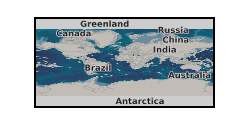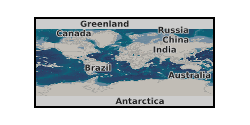Geomechanics
Type of resources
Available actions
Topics
Keywords
Contact for the resource
Provided by
Years
Formats
Representation types
Update frequencies
Scale
-

Data supporting 'Effective permeability tensors of three-dimensional numerically grown geomechanical discrete fracture networks with evolving geometry and mechanical apertures', submitted to the Journal of Geophysical Research: Solid Earth. Authors: Robin N Thomas (corresponding, robin.thomas11@imperial.ac.uk), Adriana Paluszny, Robert W Zimmerman. Department of Earth Science and Engineering, Imperial College London. Contents: For each GDFN, the geometry at each growth step. Additionally, for GDFN E, the data shown in the paper (aperture and flow distributions, figures 6 and 7) are provided, including the displacement for the mechanical case, and pressure distributions which were not shown in the manuscript. For the two SDFN sets, the geometry of the four datasets shown in figures 4 and 5 are provided. Notes: - The geometry files are provided in the .3dm format, Rhinocerous' native format (https://www.rhino3d.com/). A free trial of Rhinocerous can be used to explore the files, and can convert them to a range of other CAD file types. - VTK files can be viewed using free software such as Paraview (https://www.paraview.org/). These contain the meshes. - Fracture surface areas reported in the paper are derived from the mesh, rather than the geometry. The mesh approximates the geometry leading to a different surface area than those measured in the geometry (3dm) files. - The SDFN datasets are shown before trimming the parts of fractures which are outside the domain. These parts are trimmed when they are imported to ICGT.
-

Data supporting the publication: Robin N. Thomas, Adriana Paluszny, Robert W. Zimmerman, 2017. Quantification of fracture interaction using stress intensity factor variation maps. Journal of Geophysical Research: Solid Earth [DOI: 10.1002/2017JB014234]. Each sheet contains the data used in each figure, covering method validation, stress intensity factor perturbations, and data used to create fracture interaction maps. The data were created using the Imperial College Geomechanics Toolkit.
-

Geomechanical strength data of mudstone samples collected from the Grey Shale Member, of the Whitby Mudstone Formation of the Lias Group. Testing includes Uniaxial Compressive Strength (UCS), Indirect Tensile Strength (ITS) and Triaxial strength testing completed at the University of Leeds (UoL) and Point Load testing completed at the British Geological Survey (BGS). All sample preparation, preservation and testing were completed to the specification outlined by the ISRM (2007) unless otherwise stated. For all Triaxial testing, each sample was deformed under standard triaxial stress conditions, where the primary principal stress corresponds to the axial stress and the intermediate and minimum principal stresses are equal to that of the confining pressure. The data are separated into individual Excel files (.xlsx), with each file representing a single test. Each file contains time, force, stress, displacement, and strain data.
-

EPSRC project EP/K035878/1 - Report summarising scientific findings from Work Packages 1 to 4 of the DiSECCS project. These include advanced seismic methods for assessing pressure changes and fluid flow processes in a reservoir rock, experimental rock physics and public perceptions for CCS and analogue activities.
-

The dataset contains point load test data of salt samples collected from the Northwich Halite Member at the Winsford Mine in Cheshire, UK. Each sample was tested in an unconfined state using a point load testing apparatus, in which compressive force was applied through two opposing conical platens until failure occurred. All tests were conducted in the Rock Mechanics and Physics Laboratory at the British Geological Survey, Keyworth, UK. The dataset is compiled into a single Microsoft Excel file, with each row representing an individual test. For each test, measurements of sample length, diameter, and peak load are provided, along with calculated point load strength indices and estimates of unconfined compressive strength.
-

The dataset contains indirect tensile strength data of salt samples collected from the Northwich Halite Member at the Winsford Mine in Cheshire, UK. Each sample was unconfined and deformed under uniaxial compression, where the primary principal stress corresponds to the axial stress and the intermediate and minimum principal stresses are equal to 0. Each sample was deformed using a constant loading rate of 200 N/s. The tests were completed using a servo-controlled stiff load frame equipped with an indirect tension fixture in the Rock Mechanics and Physics Laboratory at the British Geological Survey, Keyworth UK. The data are separated into individual Microsoft Excel files, with each file representing a single test. Each file contains time, axial force, axial displacement, and tensile stress data.
-

Geomechanical strength data of mudstone samples collected from the Grey Shale Member of the Whitby Mudstone Formation of the Lias Group. Testing includes cyclic thermo-mechanical loading completed at the British Geological Survey (BGS). All sample preparation, preservation and testing were completed to the specification outlined by the ISRM (ISRM, 1978b; ISRM, 1978a; Bieniawski and Bernede, 1979; ISRM, 1985 for determining the indirect tensile strength, triaxial strength, UCS and point load strength respectively) unless otherwise stated. Each test was comprised of three main stages: 1) A heating stage where the sample is heated to a set temperature loading scheme under pressure conditions of 1-1.4 MPa axial stress and 0.5 MPa confining pressure throughout the heating stage 2) A preloading stage, where the confining pressure is increased to 5 MPa which was held throughout the triaxial compression test. 3) Triaxial compression test, during the active deformation phase, the samples were axially loaded using a constant displacement rate of 0.0012 mm s-1. The data are separated into individual Microsoft Excel files, with each file representing a single test. Each file contains time, force, stress, displacement, and strain data.
-

Report summarising the contents of the seismic analysis toolbox produced during the DiSECCS project. The toolbox comprises an online library of seismic software developed and utilised in the project, and presented in a form that other practitioners can utilise and tailor to their own specific needs. The toolbox include software for the measurement and characterisation of thin CO2 layers by spectral and attenuation analysis, fracture characterisation via wavelet coda analysis, novel rock physics algorithms and a summary of new laboratory analyses.
-

Geomechanical strength data of mudstone samples collected from the Gunthorpe Member, of the Sidmouth Mudstone Formation of the Mercia Mudstone Group. Testing includes Uniaxial Compressive Strength (UCS), Indirect Tensile Strength (ITS) and Triaxial strength testing completed at the University of Leeds (UoL) and Point Load testing and thermal loading testing completed at the British Geological Survey (BGS). All sample preparation, preservation and testing were completed to the specification outlined by the ISRM (2007) unless otherwise stated. For all Triaxial testing, each sample was deformed under standard triaxial stress conditions, where the primary principal stress corresponds to the axial stress and the intermediate and minimum principal stresses are equal to that of the confining pressure. The data are separated into individual Excel files (.xlsx), with each file representing a single test. Each file contains time, force, stress, displacement, and strain data.
-

Geomechanical strength data of mudstone samples collected from the Gunthorpe Member, of the Sidmouth Mudstone Formation of the Mercia Mudstone Group. The testing was completed at the British Geological Survey (BGS). All sample preparation, preservation and testing were completed to the specification outlined by the ISRM (ISRM, 1978b; ISRM, 1978a; Bieniawski and Bernede, 1979; ISRM, 1985 for determining the indirect tensile strength, triaxial strength, UCS and point load strength respectively) unless otherwise stated. Each test was comprised of three main stages: 1) A heating stage where the sample is heated to a set temperature loading scheme under pressure conditions of 1-1.4 MPa axial stress and 0.5 MPa confining pressure throughout the heating stage 2) A preloading stage, where the confining pressure is increased to 5 MPa which was held throughout the triaxial compression test. 3) Triaxial compression test, during the active deformation phase, the samples were axially loaded using a constant displacement rate of 0.0012 mm s-1. The data are separated into individual Microsoft Excel files, with each file representing a single test. Each file contains time, force, stress, displacement, and strain data. The data are separated into individual Excel files (.xlsx), with each file representing a single test. Each file contains time, force, stress, displacement, and strain data.
 NERC Data Catalogue Service
NERC Data Catalogue Service